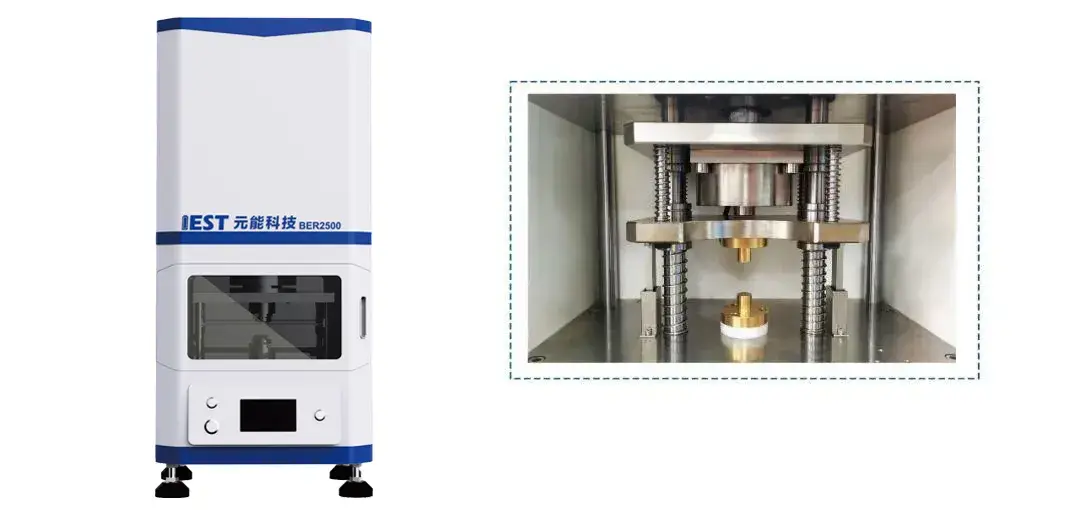-
iestinstrument
Evaluation of Graphite Electrode Bounce and Resistance Performance by Different Pressing Methods
1. Preface
This paper compares the effects of flat-compaction and roller pressing on the compaction density and resistivity of the graphite electrode to provide reference data for battery designers.
Battery energy density has always been one of the hotspots in the research of lithium-ion batteries, selecting high-capacity anode and cathode materials, and improving the compaction density of the electrode can greatly improve the battery energy density, but too high a compaction density often affects the performance of the battery multiplication, and even bring about safety hazards, so it is important to seek for the appropriate compaction density for the design of the battery. Since the actual production of the battery wafer pressing is usually used in roller pressing, but some laboratories in the preparation of a small number of wafers will also be used in the way of flat-compaction, and the current test of wafer resistance are also vertical flat-compaction, the two ways of graphite particles in the direction of the row may be different, so this paper through the comparison of flat-compaction and roller pressing of the two types of compaction on the wafer compaction density and electrical resistivity of the impact, to provide reference data support for the battery designers.

Figure 1. Diagram of anode and cathode electrode roller pressure
2.Experimental Equipment and Test Methods
2.1 Experimental Equipment
Battery Electrode Sheet Resistance Tester, model BER Series, electrode diameter of 14mm, with applied pressure of 5~60MP a; the appearance of the equipment is as shown in Figure 2.
Figure 2. (a) BER2500 appearance diagram (b) BER2500 structure diagram
2.2 Test Method
Cut the electrode to be measured into a rectangular size of about 5cm 10cm, place it on the sample table, and set the parameters such as test pressure and pressure retention time on the MRMS software to start the test. The software automatically reads the electrode thickness, resistance, resistivity, conductivity and other data.
2.3 Test Parameter
- Test the rebound amount of the graphite electrode sheet under different pressures for the unrolled and rolled electrode sheets;
- Compare the resistivity of the unrolled and rolled wafers by first compaction them flat and then re-compacted them;
- Test the resistivity of unrolled and rolled electrodes under different pressures.
3. Data Analysis
3.1 Comparison of the Rebound Amount of Electrode Thickness of Two Different Pressing Methods
The thickness rebound quantity of the graphite electrode after flat pressing and roller pressing is tested to be static for about 24h, as shown in Figure 3, from the figure, it can be seen that: when the compaction density is low, the thickness rebound quantity of the graphite electrode after flat pressing is much larger than that of the electrode after roller pressing, and the rebound quantity increases with the increase of the density of the compaction in the way of flat pressing, the rebound quantity is also increased, and the rebound quantity is increased from 0.4% in the low-pressure real to 26% in the high-pressure real; the thickness rebound quantity of the electrode after roller pressing is close to the thickness rebound quantity of the flat-pressing graphite electrode in the low-pressure real, the rebound quantity fluctuates less. The fluctuation of the rebound amount is small, the rebound amount is about 4%-12%, and so on to reach a certain compaction, the rebound amount increases sharply up to 24%, at this time, the thickness of the electrode rebound amount is close to the thickness of the graphite electrode rebound amount of flat pressure. The above phenomenon shows that in the range of small compaction density, when the roller pressing method is applied, although there is lateral shear force, but after unloading, the rebound between the particles is bigger than that when the flat pressing method is applied, but with the increase of compaction density, the rebound amount of the thickness of the electrode is basically consistent with that of the two methods of pressurization.

Figure 3. Comparison of the thickness rebound amount of roller pressure and flat pressure plate
3.2 Comparison of Resistivity of Leveling and Voltage Test Plates
The difference in resistivity before and after re-compaction is compared with that after flat-compaction of the unrolled electrode, as shown in Figure 4, from which it can be seen that: after flat-compaction of the electrode with different pressures, the resistivity of the electrode decreases as the density of compaction increases, which is a linear correlation; while after re-compaction the electrode sheet with a pressure of 5MPa and testing the resistivity of the electrode, the resistivity of the electrode increases as the density of compaction increases but the resistivity of the electrode sheet decreases as the density of compaction increases but the compaction is greater than a certain value. This phenomenon is mainly due to the fact that the contact resistance between the electrode and the surface of the electrode decreases with the increase of the test pressure in the case of flat-compaction at different pressures and the contact resistance between the particles in the coating of the electrode also decreases, whereas in the case of testing the resistivity of the electrode with different compaction densities by repressing at 5 MPa, the contact resistance between the particles in the coating of the electrode decreases, but the contact resistance between the test electrode and the surface of the electrode increases, which makes the total resistivity show the same behavior as that of the electrode. Instead, the total resistivity showed a tendency to increase with the compaction density.

Figure 4. (a) Resistivity & compaction density after flat compaction

Figure 4. (b) Resistivity & compaction after recompaction
3.3 Comparison of Electric Resistivity After Flat Compaction and Roller Pressing
The resistivity of both flat-compaction and re-compaction after roll-compaction is tested, as shown in Figure 5, from which it can be seen that: after flat-compaction and re-compaction, with the increase of compaction density, the resistivity of the electrode gradually increases and then decreases; while after roll-pressing, with the increase of compaction density, the resistivity of the electrode increases and then decreases in a relatively smooth manner, and the resistivity of the electrode, once it has passed the roll-pressing, rises significantly, and the total resistivity is greater than that of the same compaction density under the flat-compaction condition. The total resistivity is also larger than the resistivity of flat-compaction under the same compaction density condition. The above phenomenon may be the influence of roller pressing on the surface state of the electrode is greater than flat compaction, so that the contact resistance of the test electrode and the surface of the electrode is greater, or it may be due to the roller pressing method will lead to the graphite electrode sheet layer slippage so that more conductive base surface is arranged in parallel, so that the resistivity of the electrode becomes larger.

Figure 5. (a) Resistivity & compaction after flat compaction followed by re-compaction

Figure 5. (b) Resistivity & compaction after roll pressing and then re-compaction
4. Summary
This paper evaluates the rebound amount and resistance performance of graphite electrode. It is known from the above experimental data.
- Flat-compaction and roller pressing method electrode rebound amount of big difference
- The resistivity trend of the electrode after flat-compaction and re-compaction is opposite with the increase of compaction density, which may be related to the increasing contact resistance between the test electrode and the surface of the electrode after flat-compaction;
- The resistivity of the flat-compaction and roller-pressed electrodes was found to increase with the increase of compaction density, and the resistivity change trend of the two pressing methods was similar, which was that the resistivity was greater than that before pressing, and the resistivity increase of the electrode would be greater with the roller-pressing method.
※ Based on the above results of the effect of different pressing methods on the thickness bounce and resistivity, we can further combine with XRD, SEM and other characterization methods for further in-depth analysis.
5. References
[1] Sang Gun Lee, Dong Hyup Jeon. Effect of electrode compression on the wettability of lithium-ion batteries.Journal of Power Sources 265(2014) 363-369.
[2] Xu Jieru, Li Hong, etc., Conductivity test and analysis methods for research of lithium batteries. [J]. Energy Storage Science and Technology, 2018,7 (5) 926-955.
[3] Wu Xiangkun, Zhan Qiuset, Zhang LAN, Zhang Suojiang. Progress on Microstructural Optimization and Controllable Preparation Technology for Lithium Ion Battery Electrodes. [J]. Applied Chemistry, 35 (9): 1076-1092.
Contact Us
If you are interested in our products and want to know more details, please leave a message here, we will reply you as soon as we can.



